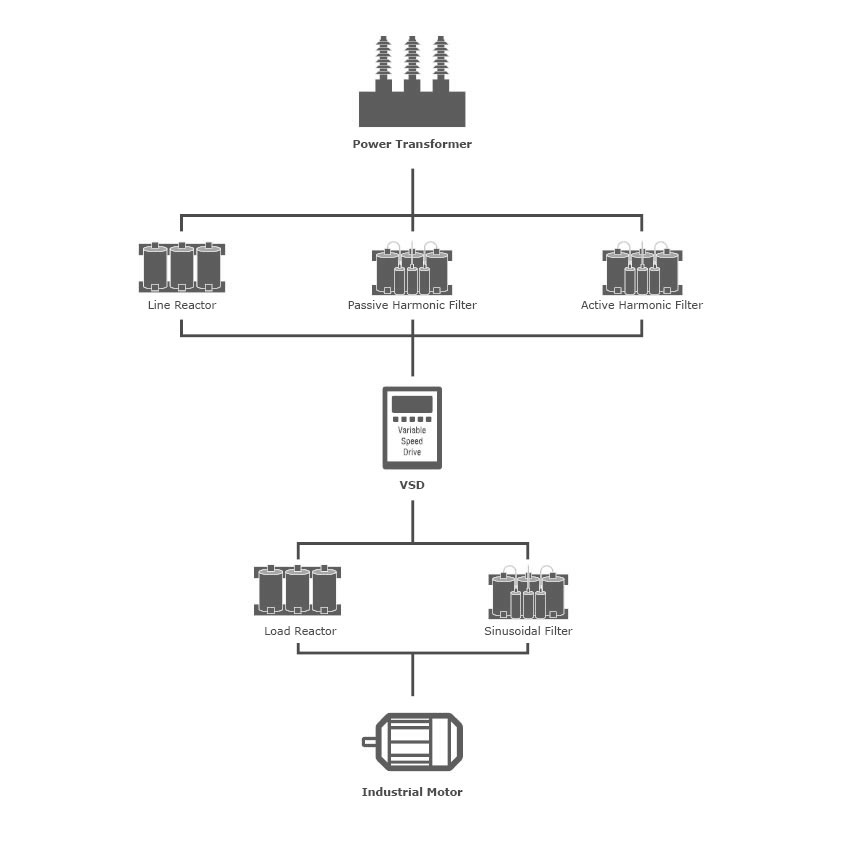The IEEE defines POWER QUALITY as the ability of a system or equipment to function satisfactorily in its electromagnetic environment without introducing intolerable electromagnetic disturbances to anything in that environment.
POWER QUALITY mainly deals with
1. Continuity of the supply.
2. Quality of the voltage.
Power quality includes: Power factor improvement, Harmonics Mitigation, Load Compensation
When do you need Harmonics Mitigation?
- Conductor Overheating
- Transformer Overheating
- Generator Instability
- Malfunction of Fuses & Circuit Breakers
- Malfunction of Utility Meters
- Drives Failure
- Flow of current in the neutral conductor Neutral Compensation
Types of Harmonics Filter
- Line and load reactors- Reactors are used to provide current limiting. Reactor opposes rapid changes in current and hence limits spikes as a result of current pulses. De-tuned reactors are installed in series with the capacitors and prevent resonance conditions by shifting the capacitor network resonance frequency below the first dominant harmonic (usually the 5th ).
- Passive harmonic filter - Uses a combination of reactors and capacitors to filter out harmonic frequencies. If the harmonic filtration is needed, on top of resonance prevention, tuned reactors are applied. The capacitors/reactors filter is tuned to absorb particular harmonic and reduce the total harmonic distortion (THD). The graph shown below harmonic filtration using tuned system: the voltage THD was reduced by more than 70% (8.8%-2.5%) and the dominant harmonics (5th and 11th) were reduced by 75%.
- Active harmonic filter - Active filters are power electronic device connected in parallel with the load to be compensated. The device can be thought of as a controlled current source, which provides any kind of current waveform in real time. When connected in parallel with the nonlinear load, its harmonic currents are compensated and the network is loaded with fundamental current only. The control system monitors the relevant parameters of the network and is capable of detecting and instantaneously reacting to any disturbance in the load current.

How does harmonic filtering work?
Harmonics are caused by non-linear loads such as Power Electronics Devices (drive, computers, rectifiers, etc.), Arcing devices, Rotating machines, Variable Frequency drives etc.
A harmonic is defined as one of the components obtained from the breakdown of a periodic wave in the Fourier series. The order of a harmonic is further defined as the ratio between the frequency of the harmonic and the fundamental frequency of the periodic wave considered. Harmonics when added together result in a distorted wave form. Voltage or current waveforms assume non-sinusoidal shape. The waveform corresponds to the sum of different sine-waves with different magnitude and phase, having frequencies that are multiples of power-system frequency result in a distorted wave form.
Harmonic filters are connected in parallel with the load to be compensated. When connected in parallel with the nonlinear load, its harmonic currents are compensated and the network is loaded with fundamental current only. It improves overheating of equipment, power quality contributing to reduced energy costs etc.
Products Range
Neptune Power Quality Product Range:-





